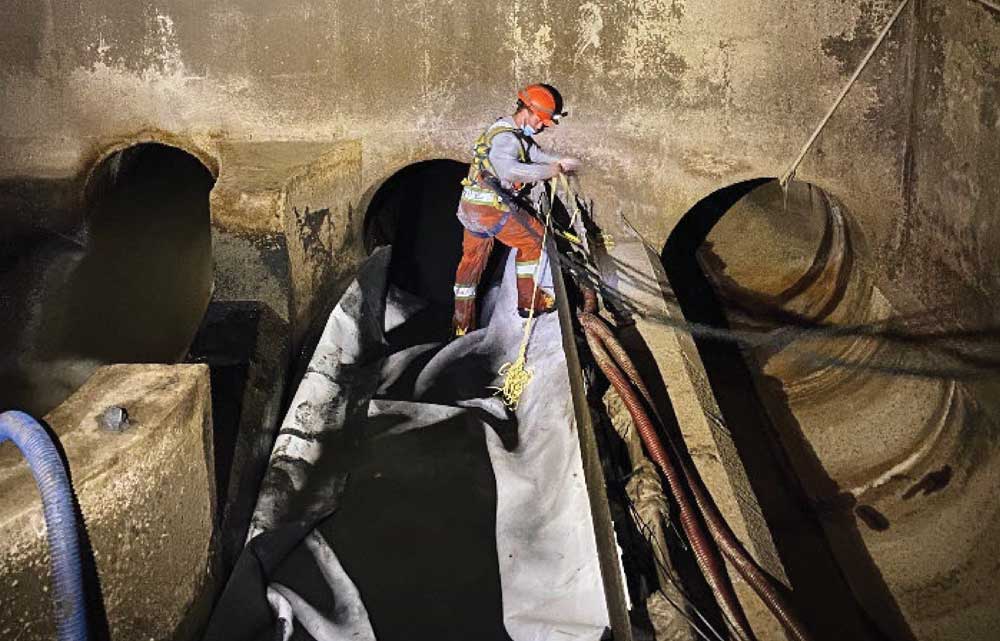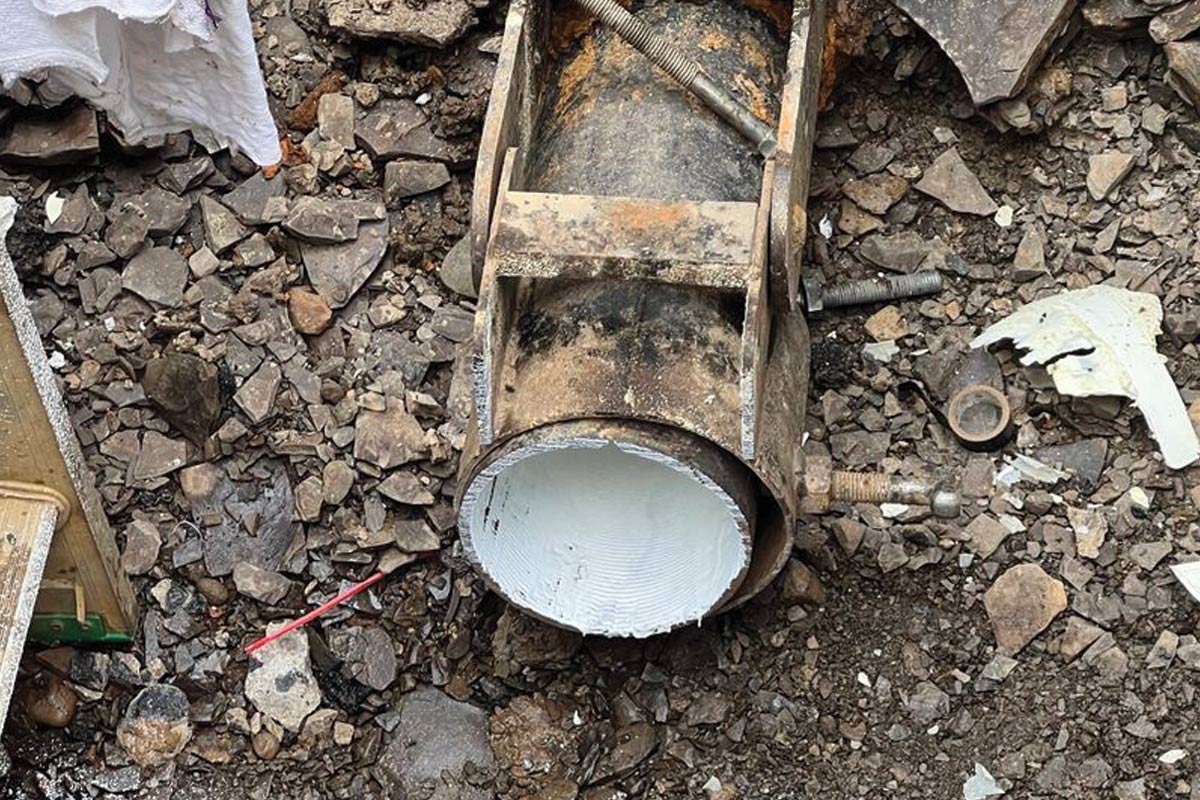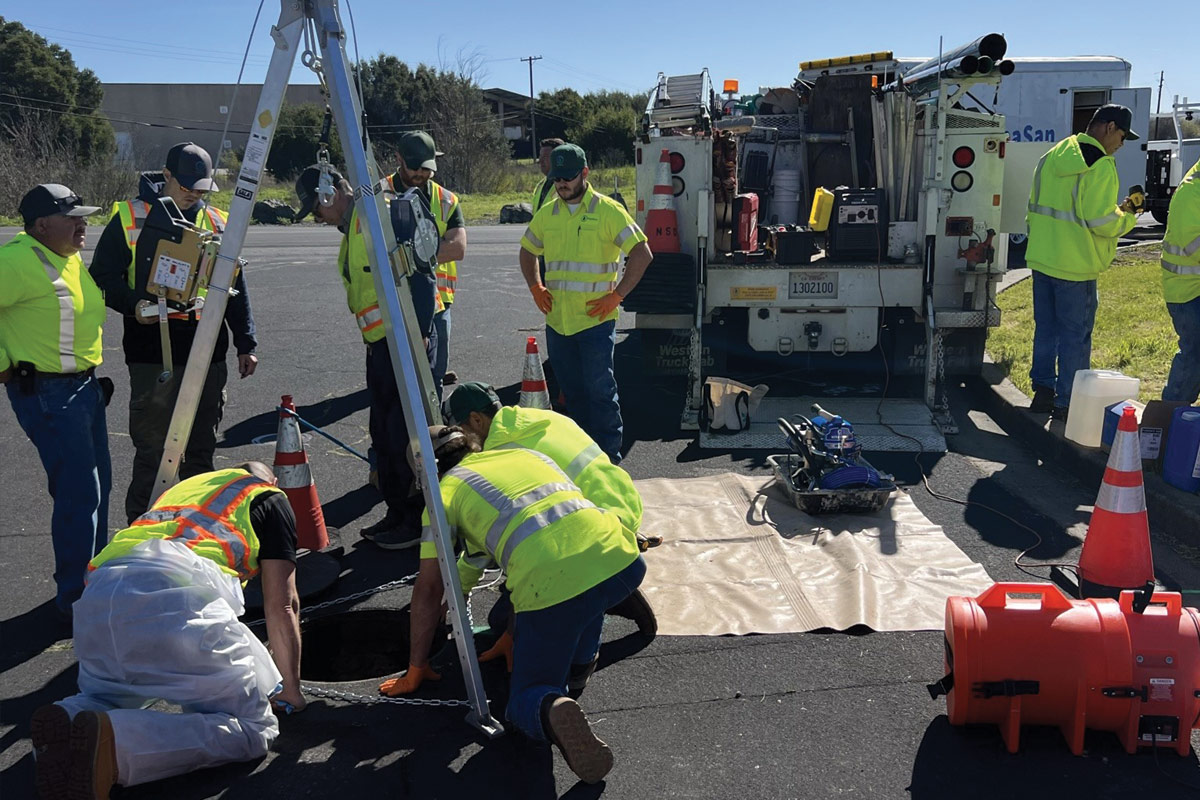
No-Dig North 2022 Canadian Project of the Year Rehabilitation
Stamford Interceptor Phase II Trunk Sewer Rehabilitation
In March 2019, the Niagara Region’s Water and Wastewater Division retained Robinson Consultants Inc. for design and construction services to rehabilitate a key trunk sewer in Niagara Falls – the region’s tourist hub.
The rehabilitation of this 1,050-mm trunk sewer was going to be no easy task as it ran adjacent to the Ontario Power Generation (OPG) hydro canal, under a well-used multipurpose recreational trail and terminated inside the Niagara Falls Wastewater Treatment Plant.
The project would require collaboration between multiple stakeholders and the team work of the owner, engineer and contractors on the project.
The Stamford Interceptor Trunk Sewer Phase II project highlights the social, environmental and economic benefits of trenchless rehabilitation technologies. The project also demonstrates significant technical advancement and complexity, milestones and records, interaction and cooperation, and industry advancement.
It is for these reasons that the Stamford Interceptor Trunk Sewer Phase II Project was selected as the No-Dig North 2022 Canadian Project of the Year for Rehabilitation.
Background
Niagara Region is tasked with providing safe drinking water to 11 municipalities across the region. To achieve this, the Region operates and maintains a network of 143 km of gravity sewers, 156 km of forcemain and 300 km of trunk watermains.
With a network of this size, it’s important to have a well thought out and proactive cleaning, inspection and assessment program to identify potential problem areas before they become disastrous. It is through this process that the Region prioritizes its repair and replacement work.
During a routine inspection and assessment in 2015, the Region first learned that Stamford Interceptor Trunk Sewer was going to need repair prompting the leadership to add the repair project – in two phases – to its capital budget.
“The Stamford interceptor is one of our main trunk sewers leading directly into the Niagara Falls Wastewater Plant. We have several pumping stations that discharge directly into it,” says Derek Falardeau-Mercier, P.Eng., senior technical project manager for the Niagara Region. “One of which is the High Lift Pumping Station which pretty much services all South Niagara Falls. Had we encountered catastrophic failure in that sewer then it would have been disastrous.”
The Stamford Interceptor Trunk Sewer runs parallel to the OPG hydro canal from Dorchester Road to the Niagara Falls Wastewater Treatment. Because of the length of the project, it was divided into two phases. Phase I was designed and completed from 2017 to 2019.
“Phase I was the rehab of 2.3 km of the upstream portion of the trunk sewer. It had signs of eminent structural failure,” says Falardeau-Mercier. “It was on the verge of failure, but we were able to address that beforehand.”
Robinson Consultants Inc. (RCI) was retained for Phase II of the project, which comprised the rehabilitation of 14 segments of 1,560 m of 1,050-mm reinforced concrete pipe (RCP) trunk sewer and 14 maintenance holes. The sewer segments and maintenance holes were in poor condition based on severe corrosion and exposed reinforcement due to hydrogen sulfide (H2S) in the pipe.

Rehabilitation Analysis
A rehabilitation technology analysis was completed for the sewer sections and maintenance holes which identified cured-in-place pipe (CIPP) as the preferred form of rehabilitation for the sewers and wall-bond spray-applied lining for the maintenance hole rehabilitation.
Based on the available rehabilitation technologies, RCI recommended CIPP because it would be the most cost-effective method, CIPP is H2S resistant and because of the sewer’s challenging location. Additionally, the areas served by the trunk sewer were a major consideration when choosing CIPP.
“The whole trunk sewer is connected to the treatment plant [on one end] and connected to a pumping station at the other end,” says Sahil Kakkar, C.E.T., field inspector at RCI. “With any other method, apart from CIPP lining, it would be hard to have the system on and off for things like wet weather events where you’d have to turn the bypass off and have the flow back into the system.”
While there are several CIPP curing options available, it was determined that a steam cure would best fit this project. However, with the project ending inside the treatment plant the Region required that all styrene condensate be treated before release into the treatment plant. This request added another layer of complexity to the project.
Negotiated Request for Proposal Process
Unlike with a typical sewer rehab project where the project is designed, goes out to bid and is usually complete by the contract that comes in with the lowest bid amount, the Region and RCI designed to use a much less common negotiated request for proposal (NRFP) method.
The development of a NRFP is only the second of its kind that RCI is aware of in the rehabilitation market, the first being issued by the City of Toronto’s Sewer Rehabilitation Program. It was also a first for the Region’s Water & Wastewater Division.
“We decided to go this route the negotiated RFP because it was more site-specific than the pre-qualification or request for tender processes. It kind of combines the two into one,” says Falardeau-Mercier. “It permitted us to review the contractor’s plan and their methodologies before we retained anyone. It gave us the opportunity to see exactly what they were planning to do. The process is non-binding and gave us the opportunity to make sure that when all the submissions came in – regardless of the bid amounts – that they were similar.”
“I liken it to comparing a Granny Smith to McIntosh apples. They are not the same apple, but they are close. It’s not like comparing apples to orange,” he adds.
Like an RFP, a contractor provides a technical submission including experience, work plan, bypass plan, materials, methods, etc. RCI and the Region evaluated all those submissions and those that met a certain technical score would proceed to a review of pricing. From there, the top three proponents based on a price per point evaluation would reach a negotiation/discussion phase with the Region and RCI.
“This allows the contractors to go back and adjust pricing based on that discussion. The contractor then submits the best and final offer. From that, the top-ranking contractor has a final negotiation [meeting] with the Region getting clarification on risks and any concerns from the Region’s standpoint,” says Lauren Young, P.Eng., project manager at RCI. “It [NRFP process] can help minimize any change orders that may come up during construction because those bigger issues are addressed earlier on ahead of time.”
Based on the outcome of this process, Kingsville, Ontario-based LiquForce was selected as the prime contractor on the project with Insituform Technologies handling the CIPP lining process and Empipe handling all the maintenance hole work.

Constructability Considerations
“The sewer runs under the Millennium Recreational Trail. Especially in the Region it is famous trail and a lot of people, even the tourists, use it,” says Kakkar. “So, the Region wanted to make sure [the project] caused the least amount of disruption and [was] done in the least amount of time.”
Coordination with the City of Niagara Falls was required for the closure of a small section of the Millennium Recreational Trail including messaging to the public and notification of the closure. Constructability considerations included accessibility along the trail, as well as restoration once the work is complete. Coordination with OPG was required regarding access to this property, which is restricted to public, construction of temporary access roads and security requirements during construction.
One of the benefits of rehabilitating this trunk sewer using CIPP as opposed to replacing the sewer was minimizing disruption to these areas. The first four sections of the trunk sewer are located directly under the Millennium Recreational Trail, a popular public trail in the City of Niagara Falls. To minimize usage disruptions, the bulk of the work took place from September to December 2021. After the peak summer tourist season and before harsh winter weather set in.
By using CIPP, and not open-cut methods, overall closure times and disruption to the trail were minimized so when the rehabilitation work was complete, the trail could be opened back up to the public with minimal restoration requirements.
Another consideration that needed to be made was with the project’s bypass. According to Falardeau-Mercier, property owners in the South Niagara Falls area experience high inflow and infiltration during wet weather events. It was paramount that the bypass system could handle any wet weather flow event if there was an unexpected rain event.
Despite the contractors checking the weather during the lining portion of the project, there was one day that had an unexpected we weather event. The system passed through as the liner was curing, so crews couldn’t let the rain waters flow through the pipeline. This meant that the Region had to come in and work with the team to help manage the flow of the water through the bypass.
“That was really one of the biggest, unexpected things that occurred, and I guess it’s something we are noticing more often…more unpredictability when it comes to the weather,” says Young.
Technical Complexities
The project also included the need to address the technical challenges with lining a significantly deteriorated sewer due to H2S, including risk of collapse during cleaning and enlarged internal diameter.
The project also had unique constructability review and coordination due to the final downstream sewer segment to be lined finishing inside the Region’s wastewater treatment plant. The constructability review required consideration of both the ability for the liner tail to enter the facility and the ability for the bypass to directly discharge into the facility.
RELATED: Preserving the Northwest Arm: Trenchless Shines on Daunting Underground Overhaul Project in Halifax
Environmental Considerations
With any municipal infrastructure project, environmental impacts are going to be a top concern. The downstream end of the sewer alignment is located within the Niagara Peninsula Conservation Authority (NPCA) Regulated Area therefore trenchless rehabilitation using CIPP was the preferred approach to minimize impact to the natural environmental. Erosion and sediment control measures including silt fencing was installed around the access roads.

One concern with CIPP projects is the release of styrene.
“Styrene odour wasn’t a big concern because it wasn’t near many residents, however, there were styrene concerns at the WWTP,” says Young. “That was a bit of a unique situation with regard to the maximum levels of styrene that could be discharged. Typically, this is not as big of a concern when you are lining further upstream, and the styrene concentration ends up diluting by the time it reaches the wastewater treatment plant.”
During the curing process,there is a small amount of styrene condensate that is produced from steam after it is cooled. This was identified as a concern during the design phase as the styrene in the discharge water can impact the wastewater treatment process, including the digestive bugs in the secondary system. As such, it was required in the contract for the contractor to have a plan to capture all styrene condensate/discharge during the curing process.
The contractor pumped the condensate into totes located at the inversion or tail maintenance hole depending on the direction of the installation. A temporary frac tank and CCG-1000T carbon filter was installed near the main bypass discharge point and the condensate water was transported to the frac tank for temporary discharge.
After the lining was completed, the captured condensate was tested for styrene concentration. The captured condensate styrene concentration reading was 2,800 µg/L. The condensate was circulated through the carbon filter until the concentration was lowered to 0.3µg/L, below the specified limit the contract of 4µg/L. The final condensate, after styrene removal, was discharged into the sanitary system.
In addition to the carbon treatment for styrene, when lining the final section into the plant, the contractor installed a sandbag berm approximately 6 to 8 ft downstream of the inlet pipe into the plant. The area was isolated with a large waterproof tarp and covered in an absorbent felt. The final inversion into the plant was completed over the top of the felt and tarp so that any residual resin run-off at the tail end of the liner was absorbed and captured.
Final Product
Contractors mobilized to the project site in September 2021 with the project substantially completed in December. According to Kakkar, the bulk of the work was setting up the bypass system. Once the bypass was completed, the 14 lining segments took place over the course of three weeks in October and November. Final restoration of the aboveground construction sites was completed in Spring 2022.
“The Stamford Project has been deemed very successful,” says Falardeau-Mercier. “I think that’s attributed to the Region, Robinson Consultants and LiquiForce working together as a team to not only get the job done but resolve unknown obstacles that came up during construction.”
Project Details
Project Owner: Niagara Region
Engineers: Robinson Consultants Inc. (Joe Linseman, P.Eng., Lauren Young, P.Eng. and Kevin Bainbridge, C.E.T.)
Contractor: LiquiForce (prime contractor), Insituform Technologies Ltd. (CIPP lining), Empipe Sewer Solutions Ltd. (manhole rehabilitation), Provincial Construction (civil construction) and Atlas Dewatering Inc. (bypass)
Value of Trenchless Project: $6 million
Date Project Completed: Substantially completed December 2021
Mike Kezdi is the managing editor of Trenchless Technology Canada.




